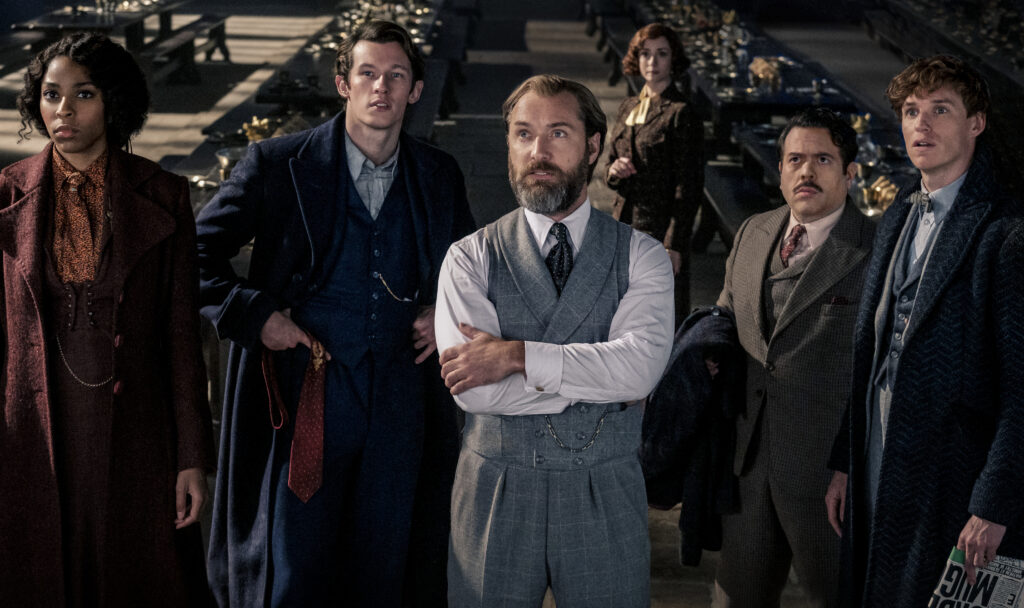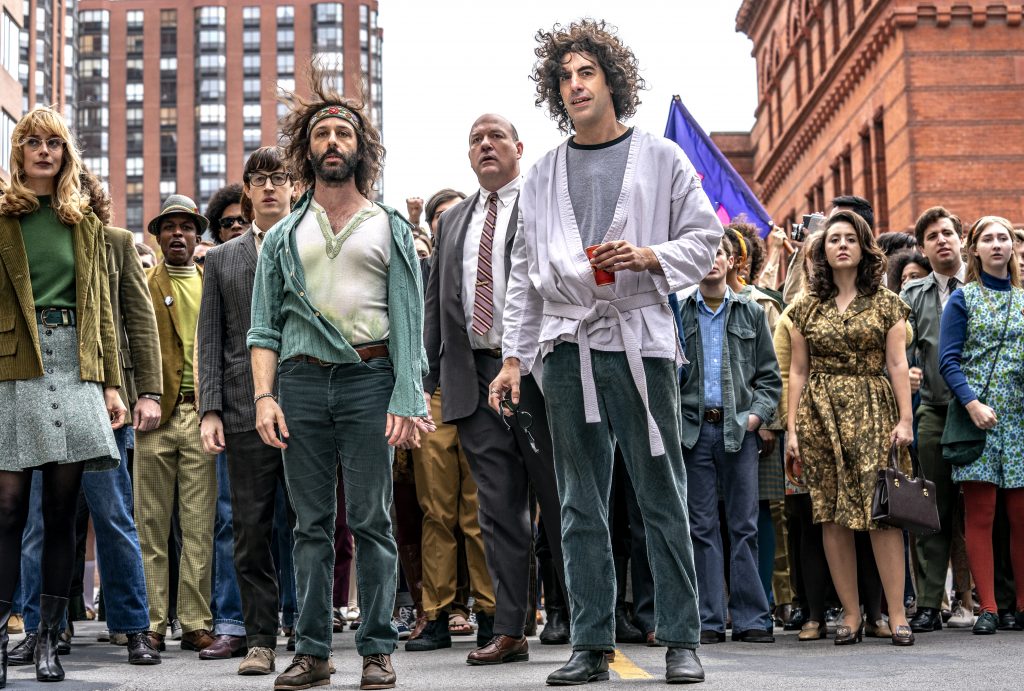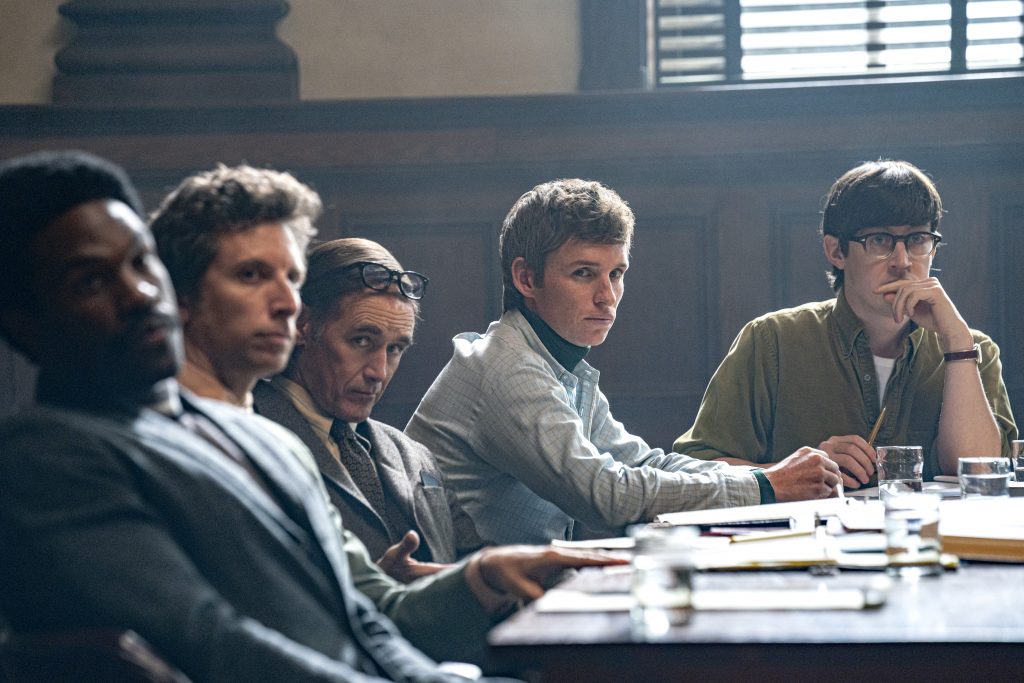October 26, 2022
by Carla Hay
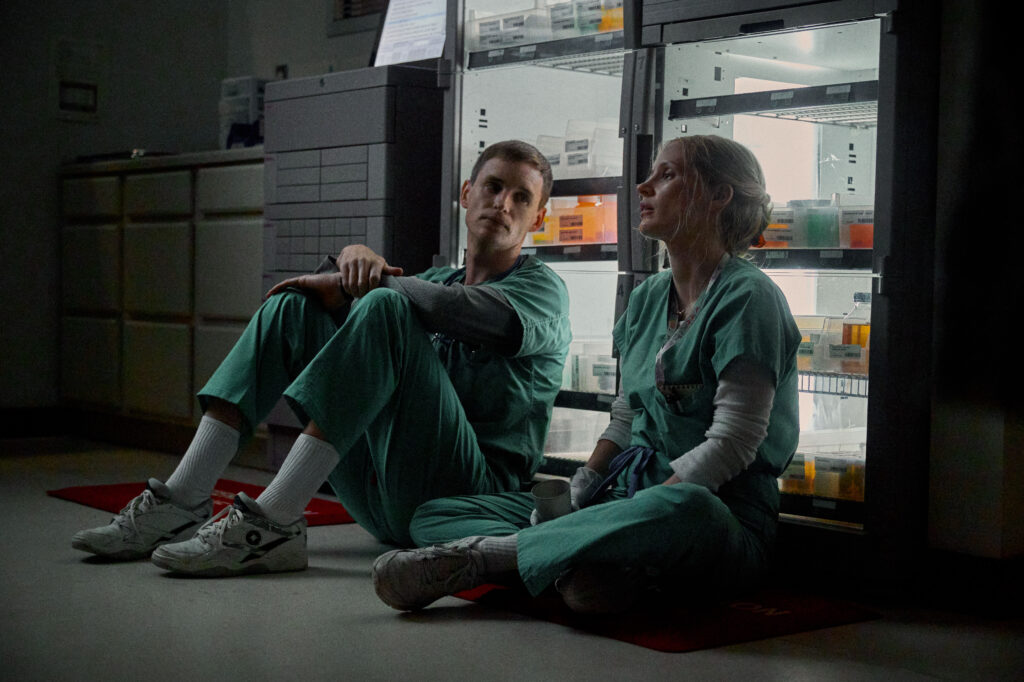
Directed by Tobias Lindholm
Culture Representation: Taking place mostly in 2003 in New Jersey, the dramatic film “The Good Nurse” (based on real events) features a predominantly white cast of characters (with a few African Americans and Latinos) representing the working-class and middle-class.
Culture Clash: A hospital nurse begins to suspect that a male co-worker nurse, who has become her friend, is murdering patients with secret drug overdoses.
Culture Audience: “The Good Nurse” will appeal primarily to people who are fans of stars Jessica Chastain and Eddie Redmayne and well-acted dramas about true crimes.
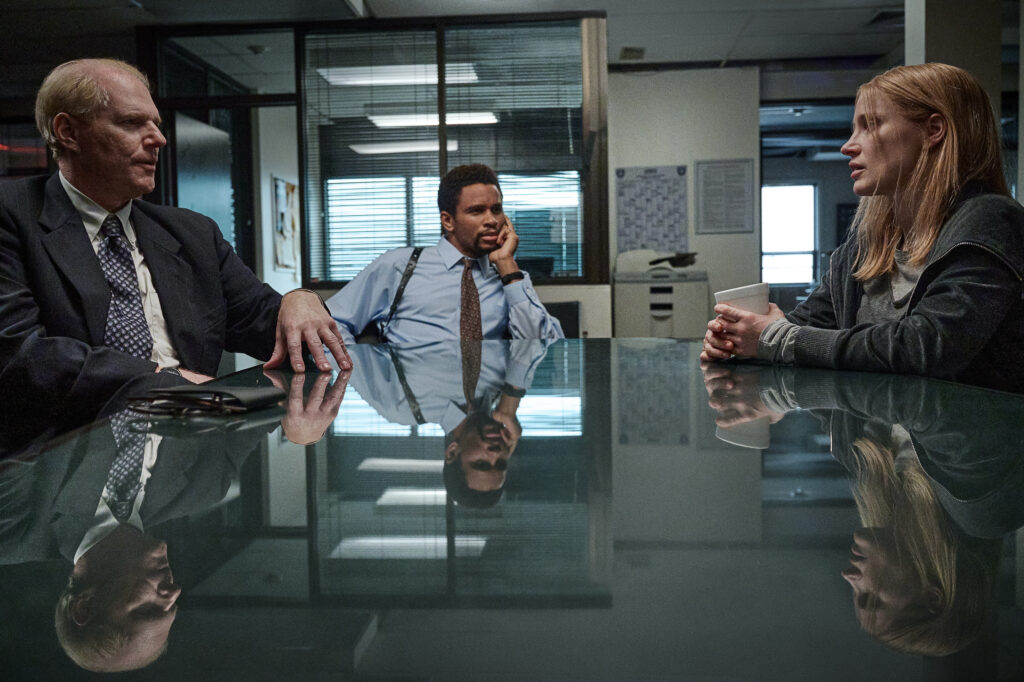
“The Good Nurse” can be as clinical and drab as the hospital settings where this true-crime drama takes place. However, the principal cast members’ performances stand out in this otherwise formulaic movie. “The Good Nurse” is told from the perspective of a hospital nurse who became a whistleblower in cases that exposed one of her co-workers as a hospital serial killer. This murderer was able to get away with his crimes at various hospitals during the 16 years that he was a nurse, until his co-worker helped investigators capture this murderer. None of this is spoiler information, since the movie uses the real names of the serial killer and the whistleblower nurse in this news-making scandal.
Directed by Tobias Lindholm, “The Good Nurse” is based on Charles Graeber’s 2013 non-fiction book “The Good Nurse: A True Story of Medicine, Madness, and Murder.” Krysty Wilson-Cairns wrote the adapted screenplay for “The Good Nurse,” a movie that had its world premiere at the 2022 Toronto International Film Festival. Although one person was ultimately convicted of the murders depicted in “The Good Nurse,” the movie is an obvious and scathing indictment of a system of hospital administrators who suspected this nurse of being a serial killer but did nothing about it or possibly covered up evidence, as he moved from hospital job to hospital job.
“The Good Nurse” takes place mostly in 2003 in New Jersey, but the movie begins with a flashback scene at St. Aloysius Hospital in Pennsylvania in 1996. The scene shows a patient (who is not seen on camera, except for the patient’s feet at the end of a hospital bed) getting emergency treatment, even though the patient’s vital signs indicate that the patient is dead. While a doctor and other medical attendants frantically try to revive the patient without success, a nurse named Charles “Charlie” Cullen (played by Eddie Redmayne) stands by quietly in the room and observes. Even if viewers don’t know in advance who the villain is in the story, Redmayne’s creepy and furtive portrayal of Charlie makes it obvious that he’s a character with a lot of secrets.
The movie then flashes forward to 2003, at Parkfield Memorial Hospital in New Jersey. Hospital nurse Amy Loughren (played by Jessica Chastain) is a new employee at Parkfield Memorial and eager to make a good impression on people. Amy is a single mother of two daughters: feisty Alex Loughren (played by Alix West Lefler), who’s about 8 or 9 years old, and obedient Maya Loughren (played by Devyn McDowell), who’s about 4 or 5 years old. The children’s father is not seen or mentioned in the movie. Amy and Alex have a tension-filled relationship, because Alex thinks that her mother, who works the night shift, doesn’t pay enough attention to Alex and Maya.
Amy is actually hiding a big secret from almost everyone she knows: She’s been diagnosed with cardiomyopathy, a heart condition that could lead to a fatal heart attack or fatal stroke if Amy is under a great deal of stress. Amy’s doctor tells her that she needs a heart transplant and should no longer do the type of stressful work that she’s doing. Amy can’t quit her job because she needs the health insurance to pay for the operation. As a new employee, Amy also won’t get paid medical leave until she’s been on the job for six months.
Amy is already financially struggling, so she’s under tremendous pressure to keep her job for the health insurance, even though the job can be detrimental to her health. Amy’s doctor advises her to tell Alex about the warning signs to look for if Amy is having a stroke, such shortness of breath, pressure in the chest, or feeling weak or faint. However, Amy is reluctant to take this advice because she doesn’t want to her kids to worry about her health. This movie depicts Amy as a loner who doesn’t have any close friends or family members to rely on for support. She gets childare help from a middle-aged babysitter named Jackie (played by Marcia Jean Kurtz), who doesn’t mind if Amy is sometimes late in paying her.
Meanwhile, at Parkfield Memorial, Amy is a compassionate nurse who sometimes bends the rules for patients if it will help the patients be more comfortable. For example, near the beginning of the movie, Amy is tending to an elderly patient named Ana Martinez (played by Judith Delgado), who is being visited by her devoted husband, Sam Martinez (played by Jesus-Papoleto Melendez). During one of these visits, Sam asks to stay in the hospital room overnight with his wife, even though it’s against the hospital rules for visitors to stay past visiting hours.
Amy allows this overnight stay, but she’s reprimanded for it later by her boss Vivian Neal (played by Myra Lucretia Taylor), after Vivian finds out about this breach of protocol. Vivian says when she’s scolding Amy that the hospital isn’t a hotel. Vivian also mentions that the hospital is putting her under a lot of financial scrutiny for expenses. Amy takes the criticism in stride, but it’s the movie’s first indication that the hospital is run like a corporation focused on profits.
Amy soon meets Charlie, one of the other night-shift nurses who has Ana Martinez as a patient. Just like Amy, Charlie is a loner, who seems to be quiet and introverted. Amy and Charlie start talking with each other, and they eventually become work friends. Charlie confides in Amy about his personal problems: He is in a bitter custody battle with his ex-wife over their underage children. According to Charlie, his ex-wife lies about him so that she can try to win the custody battle.
Not long after Charlie and Amy meet, Ana Martinez dies. Amy and Charlie happen to be in the hospital room where Ana’s body is laying on the hospital bed before Charlie has to clean the body in preparation for the corpse to be taken to the hospital morgue. In this moment, Charlie tells Amy that his mother died in a hospital, which misplaced his mother’s body for a few hours. As soon as Charlie makes this revelation, you don’t have to be a psychiatrist to know he’s probably got anger and revenge issues related to how his mother died and how the hospital mishandled her death.
As nurses, Amy and Charlie have access to the hospital’s medication supply room and are responsible for administering medication to patients. Amy is trusting of Charlie and, at first, she doesn’t think there’s anything suspicious about him. She also doesn’t suspect that Ana died of anything but natural causes, until Amy sees internal hospital records much later in the movie.
Eventually, Amy tells Charlie her secret about having cardiomyopathy, when he notices during their work shift that she has difficulty breathing and she almost faints. She also tells him about her health insurance predicament, and she begs him to not to tell anyone else. Amy has also been secretly stealing some medication from the hospital supply room to ease some of her physical pain, and she confesses this secret to Charlie. At the time that Amy confides in Charlie about her cardiomyopathy, she has to wait about four months until she has the health insurance to pay for her heart operation and can go on a paid medical leave.
Charlie is immediately sympathetic to Amy. He gives Amy pep talks and offers to help her as much as he can. Charlie repeatedly tells Amy that the two of them will get through her ordeal together. Amy trusts Charlie enough to invite him into her home and introduce him to her children. She notices that Charlie is especially good with Alex, who responds warmly to Charlie’s friendliness. It’s a relief for Amy, because Alex is often hostile or aloof with Amy, and Charlie always seems to put Alex in a good mood.
But trouble is brewing at Parkfield Memorial. Two police detectives are investigating Ana Martinez’s death: Tim Braun (played by Noah Emmerich) and Danny Baldwin (played by Nnamdi Asomugha), who are asked by hospital officials to do a formal investigation. Why? The hospital’s board of directors wants to make sure that there won’t be any issues that would make the hospital liable for Ana’s death. The supervisor for Tim and Danny is Sam Johnson (played by Malik Yoba), who has a high standard for the evidence that must be gathered before any arrests are made.
The two Parkfield Memorial Hospital officials who interact the most with the police detectives are Linda Garran (played by Kim Dickens) and attorney Duncan Beattie (played by David Lavine), who are portrayed as cold-hearted corporate types. Linda and Duncan are reluctant for this investigation to happen and stonewall the detectives any way that they can. A city council member named Malcolm Burrel (played by Bruce MacVittie) gets involved in the political aspects of the investigation.
Linda and Duncan assemble a meeting with Parkfield Memorial Hospital employees (including Amy and Charlie) to inform everyone that the investigation is taking place. The employees in this meeting are warned not to talk to police without a Parkfield Memorial official present during the interview. Duncan also sternly reminds the employees about a confidentiality clause in their employee contract, which is his way of saying that an employee can be fired for disclosing information about the hospital and patients without the hospital’s permission.
You know where all of this is going, of course. The rest of the “The Good Nurse” follows a crime procedural formula that has been done before in many movies of this ilk. Danny is the first of the two detectives to become more suspicious of Charlie, especially when the cops find out that Charlie was one of the nurses who had access to medication given to Ana; the hospital conducted an internal seven-week investigation into Ana’s death; and the hospital did not fully disclose the results of the investigation to Ana’s family.
During a background check of Charlie, the detectives find out that Charlie isn’t quite the “nice guy with a harmless reputation” that he seems to be. Charlie had a prior arrest for criminal trespassing (he was accused by an ex-girlfriend/ex-co-worker of slashing her tires), but his accuser eventually dropped the charges. The detectives also find it suspicious that Charlie worked at nine other hospitals that will only confirm his dates of employment and won’t divulge any information about what Charlie was like as an employee. (For legal reasons, it’s standard procedure for previous employers not to give out information about past employees except for the dates that they were employed.)
Eventually, Amy gets suspicious of Charlie and does her own investigating. She’s in a lot of denial at first because Charlie is her friend. She’s also worried about getting fired if she secretly cooperates with the police. Danny and Tim have moments where they are hotheaded and lose their tempers. But, for the most part, they are fairly generic cop characters. When Charlie is questioned by these two detectives, Danny plays the “good cop” role, while Tim plays the “bad cop” role.
Chastain and Redmayne both give nuanced performances that show how easily people can be manipulated by sociopaths who want to project the image of being “nice and friendly” people. Charlie’s disturbed mental state doesn’t become truly obvious until a pivotal scene in an interrogation room. However, Redmayne’s performance always shows hints that something is not quite right about Charlie, based on the way that Charlie observes and interacts with people,
The character of Amy could have been developed better, but the movie fulfills its purpose with this character if it intended to make her look like someone who didn’t have a social life outside of Charlie. However, Chastain goes a good job of conveying the inner conflict and turmoil that Amy experienced in this criminal case, in addition to Amy dealing with her own health crisis. The cinematography of “The Good Nurse,” which has a lot of gray-blue lighting and hues, is a reflection of this movie’s constant melancholic tone.
“The Good Nurse” could have used more empathy and screen time in letting viewers know more about the victims and their families who were portrayed in the film. The movie also hints at but never says out loud something that’s very obvious to people who have enough life experience: Charlie probably got away with all that he got away with because of racial issues and having the privilege of being part of a majority race. (Studies have shown that hospital serial killers in any country are almost always of the majority race in that country.)
In other words, it’s hard to imagine the real-life Charlie Cullen being able to get away with his crimes for as long as he did if he were a race other than white. In the movie’s blatant attempt to put equal blame for these crimes on a hospital system as on the killer, “The Good Wife” doesn’t really want to acknowledge the racial disparities in American healthcare, when it comes to which races get better treatment overall in the U.S. health care system, compared to other races. As heroic as Amy Loughren is portrayed in “The Good Nurse,” her character and this movie have a blind spot about racial inequalities in America’s healthcare and criminal justice system. These racial inequalities, which are not acknowledged in the movie, enabled a serial killer in real life to get away with his murders for as long as he did.
Netflix released “The Good Nurse” in select U.S. cinemas on October 19, 2022. The movie premiered on Netflix on October 26, 2022.

